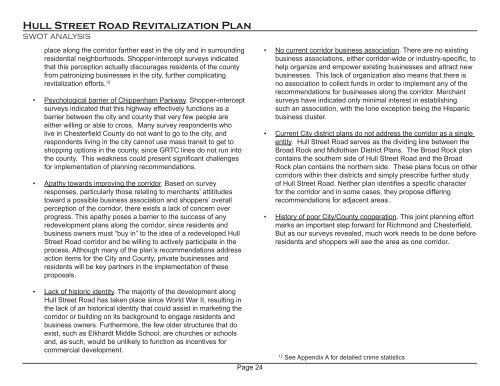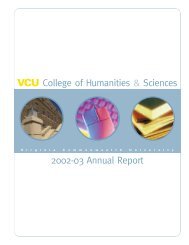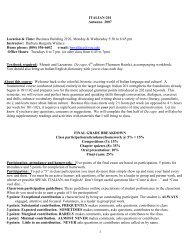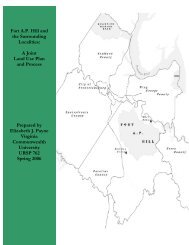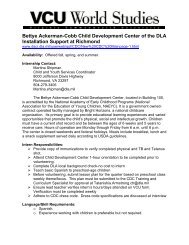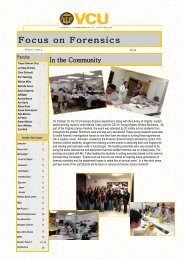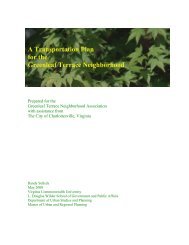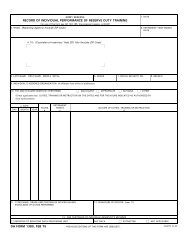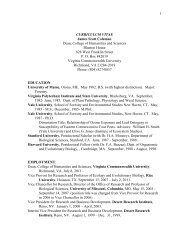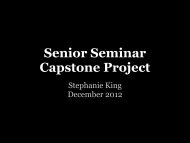Hull Street Road Revitalization Plan - College of Humanities and ...
Hull Street Road Revitalization Plan - College of Humanities and ...
Hull Street Road Revitalization Plan - College of Humanities and ...
Create successful ePaper yourself
Turn your PDF publications into a flip-book with our unique Google optimized e-Paper software.
<strong>Hull</strong> <strong>Street</strong> <strong>Road</strong> <strong>Revitalization</strong> <strong>Plan</strong><br />
SWOT ANALYSIS<br />
place along the corridor farther east in the city <strong>and</strong> in surrounding<br />
residential neighborhoods. Shopper-intercept surveys indicated<br />
that this perception actually discourages residents <strong>of</strong> the county<br />
from patronizing businesses in the city, further complicating<br />
revitalization efforts. 12<br />
• Psychological barrier <strong>of</strong> Chippenham Parkway. Shopper-intercept<br />
surveys indicated that this highway effectively functions as a<br />
barrier between the city <strong>and</strong> county that very few people are<br />
either willing or able to cross. Many survey respondents who<br />
live in Chesterfield County do not want to go to the city, <strong>and</strong><br />
respondents living in the city cannot use mass transit to get to<br />
shopping options in the county, since GRTC lines do not run into<br />
the county. This weakness could present significant challenges<br />
for implementation <strong>of</strong> planning recommendations.<br />
• Apathy towards improving the corridor. Based on survey<br />
responses, particularly those relating to merchants’ attititudes<br />
toward a possible business association <strong>and</strong> shoppers’ overall<br />
perception <strong>of</strong> the corridor, there exists a lack <strong>of</strong> concern over<br />
progress. This apathy poses a barrier to the success <strong>of</strong> any<br />
redevelopment plans along the corridor, since residents <strong>and</strong><br />
business owners must “buy in” to the idea <strong>of</strong> a redeveloped <strong>Hull</strong><br />
<strong>Street</strong> <strong>Road</strong> corridor <strong>and</strong> be willing to actively participate in the<br />
process. Although many <strong>of</strong> the plan’s recommendations address<br />
action items for the City <strong>and</strong> County, private businesses <strong>and</strong><br />
residents will be key partners in the implementation <strong>of</strong> these<br />
proposals.<br />
• Lack <strong>of</strong> historic identity. The majority <strong>of</strong> the development along<br />
<strong>Hull</strong> <strong>Street</strong> <strong>Road</strong> has taken place since World War II, resulting in<br />
the lack <strong>of</strong> an historical identity that could assist in marketing the<br />
corridor or building on its background to engage residents <strong>and</strong><br />
business owners. Furthermore, the few older structures that do<br />
exist, such as Elkhardt Middle School, are churches or schools<br />
<strong>and</strong>, as such, would be unlikely to function as incentives for<br />
commercial development.<br />
Page 24<br />
• No current corridor business association. There are no existing<br />
business associations, either corridor-wide or industry-specific, to<br />
help organize <strong>and</strong> empower existing businesses <strong>and</strong> attract new<br />
businesses. This lack <strong>of</strong> organization also means that there is<br />
no association to collect funds in order to implement any <strong>of</strong> the<br />
recommendations for businesses along the corridor. Merchant<br />
surveys have indicated only minimal interest in establishing<br />
such an association, with the lone exception being the Hispanic<br />
business cluster.<br />
• Current City district plans do not address the corridor as a single<br />
entity. <strong>Hull</strong> <strong>Street</strong> <strong>Road</strong> serves as the dividing line between the<br />
Broad Rock <strong>and</strong> Midlothian District <strong>Plan</strong>s. The Broad Rock plan<br />
contains the southern side <strong>of</strong> <strong>Hull</strong> <strong>Street</strong> <strong>Road</strong> <strong>and</strong> the Broad<br />
Rock plan contains the northern side. These plans focus on other<br />
corridors within their districts <strong>and</strong> simply prescribe further study<br />
<strong>of</strong> <strong>Hull</strong> <strong>Street</strong> <strong>Road</strong>. Neither plan identifies a specific character<br />
for the corridor <strong>and</strong> in some cases, they propose differing<br />
recommendations for adjacent areas.<br />
• History <strong>of</strong> poor City/County cooperation. This joint planning effort<br />
marks an important step forward for Richmond <strong>and</strong> Chesterfield.<br />
But as our surveys revealed, much work needs to be done before<br />
residents <strong>and</strong> shoppers will see the area as one corridor.<br />
12<br />
See Appendix A for detailed crime statistics


